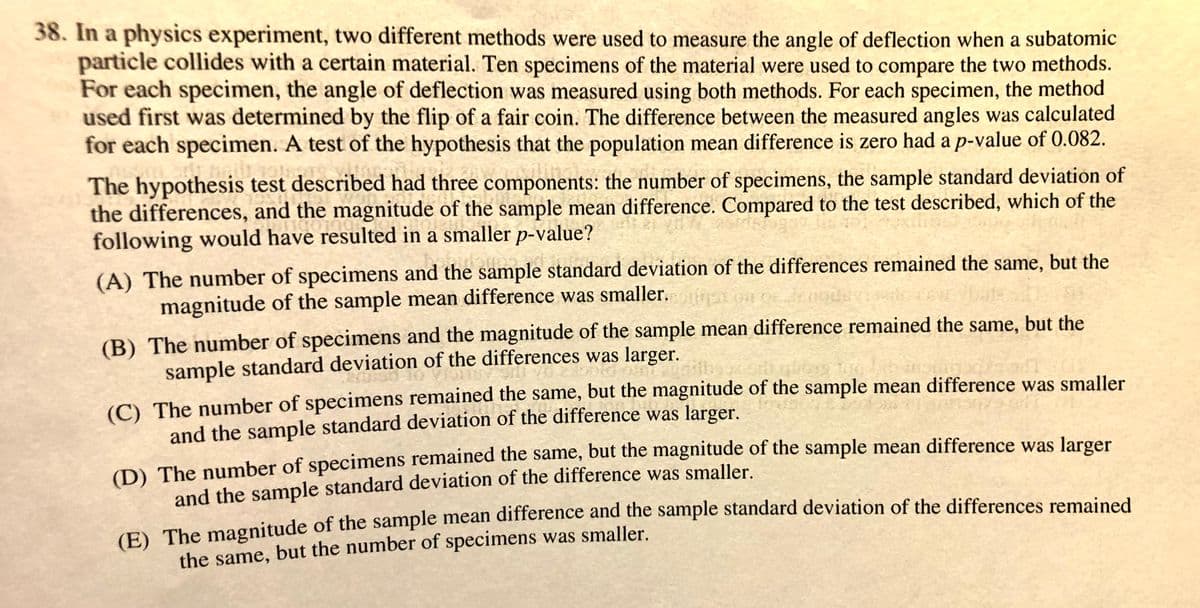38. In a physics experiment, two different methods were used to measure the angle of deflection when a subatomic particle collides with a certain material. Ten specimens of the material were used to compare the two methods. For each specimen, the angle of deflection was measured using both methods. For each specimen, the method used first was determined by the flip of a fair coin. The difference between the measured angles was calculated for each specimen. A test of the hypothesis that the population mean difference is zero had a p-value of 0.082. The hypothesis test described had three components: the number of specimens, the sample standard deviation of the differences, and the magnitude of the sample mean difference. Compared to the test described, which of the following would have resulted in a smaller p-value? (A) The number of specimens and the sample standard deviation of the differences remained the same, but the magnitude of the sample mean difference was smaller. (B) The number of specimens and the magnitude of the sample mean difference remained the same, but the sample standard deviation of the differences was larger. (C) The number of specimens remained the same, but the magnitude of the sample mean difference was smaller and the sample standard deviation of the difference was larger. (D) The number of specimens remained the same, but the magnitude of the sample mean difference was larger and the sample standard deviation of the difference was smaller. (E) The magnitude of the sample mean difference and the sample standard deviation of the differences remained the same, but the number of specimens was smaller.
38. In a physics experiment, two different methods were used to measure the angle of deflection when a subatomic particle collides with a certain material. Ten specimens of the material were used to compare the two methods. For each specimen, the angle of deflection was measured using both methods. For each specimen, the method used first was determined by the flip of a fair coin. The difference between the measured angles was calculated for each specimen. A test of the hypothesis that the population mean difference is zero had a p-value of 0.082. The hypothesis test described had three components: the number of specimens, the sample standard deviation of the differences, and the magnitude of the sample mean difference. Compared to the test described, which of the following would have resulted in a smaller p-value? (A) The number of specimens and the sample standard deviation of the differences remained the same, but the magnitude of the sample mean difference was smaller. (B) The number of specimens and the magnitude of the sample mean difference remained the same, but the sample standard deviation of the differences was larger. (C) The number of specimens remained the same, but the magnitude of the sample mean difference was smaller and the sample standard deviation of the difference was larger. (D) The number of specimens remained the same, but the magnitude of the sample mean difference was larger and the sample standard deviation of the difference was smaller. (E) The magnitude of the sample mean difference and the sample standard deviation of the differences remained the same, but the number of specimens was smaller.
Algebra & Trigonometry with Analytic Geometry
13th Edition
ISBN:9781133382119
Author:Swokowski
Publisher:Swokowski
Chapter2: Equations And Inequalities
Section2.1: Equations
Problem 75E
Related questions
Question
#38 AP

Transcribed Image Text:38. In a physics experiment, two different methods were used to measure the angle of deflection when a subatomic
particle collides with a certain material. Ten specimens of the material were used to compare the two methods.
For each specimen, the angle of deflection was measured using both methods. For each specimen, the method
used first was determined by the flip of a fair coin. The difference between the measured angles was calculated
for each specimen. A test of the hypothesis that the population mean difference is zero had a p-value of 0.082.
The hypothesis test described had three components: the number of specimens, the sample standard deviation of
the differences, and the magnitude of the sample mean difference. Compared to the test described, which of the
following would have resulted in a smaller p-value?
(A) The number of specimens and the sample standard deviation of the differences remained the same, but the
magnitude of the sample mean difference was smaller. inet oa
(B) The number of specimens and the magnitude of the sample mean difference remained the same, but the
sample standard deviation of the differences was larger.
(C) The number of specimens remained the same, but the magnitude of the sample mean difference was smaller
and the sample standard deviation of the difference was larger.
(D) The number of specimens remained the same, but the magnitude of the sample mean difference was larger
and the sample standard deviation of the difference was smaller.
E The magnitude of the sample mean difference and the sample standard deviation of the differences remained
the same, but the number of specimens was smaller.
Expert Solution
This question has been solved!
Explore an expertly crafted, step-by-step solution for a thorough understanding of key concepts.
This is a popular solution!
Trending now
This is a popular solution!
Step by step
Solved in 2 steps with 2 images

Recommended textbooks for you

Algebra & Trigonometry with Analytic Geometry
Algebra
ISBN:
9781133382119
Author:
Swokowski
Publisher:
Cengage

Algebra & Trigonometry with Analytic Geometry
Algebra
ISBN:
9781133382119
Author:
Swokowski
Publisher:
Cengage